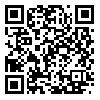Volume 9, Issue 1 (Winter 2020)
Arch Hyg Sci 2020, 9(1): 69-76 |
Back to browse issues page
Download citation:
BibTeX | RIS | EndNote | Medlars | ProCite | Reference Manager | RefWorks
Send citation to:



BibTeX | RIS | EndNote | Medlars | ProCite | Reference Manager | RefWorks
Send citation to:
Sedaghatzadegan S, Sarbandi F. Assessment of Risky Traffic Behaviors in Kashan Population in 2018. Arch Hyg Sci 2020; 9 (1) :69-76
URL: http://jhygiene.muq.ac.ir/article-1-438-en.html
URL: http://jhygiene.muq.ac.ir/article-1-438-en.html
1- Associate Professor, Department of Social Sciences, Payame Noor University, Tehran, Iran
2- MSc student of Sociology, Payam Noor University, Tehran, Iran
2- MSc student of Sociology, Payam Noor University, Tehran, Iran
Abstract: (2646 Views)
Background & Aims of the Study: Risky driving behaviors are a set of actions that put drivers at the risk of death or injuries which are caused by the violations of legal standards. These kinds of behaviors are the key factor leading to a higher risk of traffic crashes and injuries. The present study aimed to investigate the situation of some high-risk traffic behaviors and the related factors in Kashan.
Materials and Methods: In this descriptive cross-sectional study, 400 people were selected from among Kashan population by convenience sampling method. The self-reporting questionnaire consisted of two parts: demographic information (e.g., gender, age, marital status, level of education of the person and parents, and family income) and the number of traffic violations (e.g., paid fines, running red lights, parking prohibited in specified places, as well as unauthorized overtaking and speeding).Data were analyzed in SPSS software (version 16) using descriptive statistics (e.g., frequency distribution, central and dispersion indices) and inferential statistics (e.g., independent t-test, analysis of variance, and chi-square).Results: The current study was conducted on 400 drivers who were selected from among Kashan population (314 men and 86 women) with the mean age of 38.15±10.29. The obtained results indicated that women were safer drivers. Moreover, it was found that people in older age groups committed fewer violations. In addition, the frequency of unauthorized speeding and overtaking was significantly higher among single people, as compared to the married ones. Regarding educational level, the frequency of unauthorized parking and overtaking was higher among the people with higher levels of education. Moreover, the frequency of unauthorized speeding was significantly higher among those with higher family income (P<0.05). |
Type of Study: Original Article |
Subject:
General
Received: 2019/12/25 | Accepted: 2020/02/15 | Published: 2020/03/29
Received: 2019/12/25 | Accepted: 2020/02/15 | Published: 2020/03/29
References
1. Roberts I, Mohan D, Abbasi K. War on the roads. BMJ. 2002;324(7346):1107-8. [DOI:10.1136/bmj.324.7346.1107]
2. WHO. Global status report on road safety 2018. Geneva, Switzerland: World Health Organization; 2018.
3. Azami-Aghdash S, Gorji HA, Sadeghi-Bazargani H, Shabaninejad H. Epidemiology of road traffic injuries in Iran: based on the data from Disaster Management Information System (DMIS) of the Iranian Red Crescent. Iranian Red Crescent Medical Journal. 2017;19(1):e38743. [DOI:10.5812/ircmj.38743]
4. Behnood HR, Haddadi M, Sirous S, Ainy E, Rezaei R. Medical costs and economic burden caused by road traffic injuries in Iran. Trauma monthly. 2016;22(2):e35997. [DOI:10.5812/traumamon.35997]
5. Pakgouhar AR, Khalili M, Safarzadeh M. The consideration of human factor's role in occurrence and aggravation of road accidents based on the regression models LR and CART. Traffic management studies. 2009;4(13):49-66.
6. Bakhtiyari M, Soori H. Epidemiology of traffic crashes outcomes and related factors in Iran 2010. Journal of safety promotion and injury prevention. 2013;1(3):150-59.
7. Khosravi Shadmani F, Soori H, Karami M, Zayeri F, Mehmandar MR. Estimating of population attributable fraction of unauthorized speeding and overtaking on rural roads of Iran. Iranian journal of epidemiology. 2013;8(4):9-14.
8. Mäkinen T, Zaidel DM, Andersson G, Biecheler-Fretel M-B, Christ R, Cauzard J-P, et al. Traffic enforcement in Europe: effects, measures, needs and future. Final report of the ESCAPE (Enhanced Safety Coming from Appropriate Police Enforcement) consortium. 2003.
9. Peden M, Scurfield R, Sleet D, Mohan D, Hyder AA, Jarawan E, et al. World report on road traffic injury prevention. World Health Organization Geneva; 2004.
10. Sehat M, Naieni KH, Asadi-Lari M, Foroushani AR, Malek-Afzali H. Socioeconomic Status and Incidence of Traffic Accidents in Metropolitan Tehran: A Population-based Study. Int J Prev Med. 2012;3(3):181-90.
11. Ferdousi T, Sarami GR, Rostami AR. A comparative study of psychological factors influencing car crashes according to the driver's gender. Woman in development and politics (women's research). 2011;8(4):141-57.
12. Shinar D, Schechtman E, Compton R. Self-reports of safe driving behaviors in relationship to sex, age, education and income in the US adult driving population. Accident Analysis & Prevention. 2001;33(1):111-6. [DOI:10.1016/S0001-4575(00)00021-X]
13. Alavi SS MM, Soori H, Jannatifard F, Mohammadi-alhory S. The Determination of Cognitive-Behavioral Features of Bus and Truck Drivers during Road Accidents in 2013-2014. J Saf Promot Inj Prev. 2016;3(4):223-32.
14. Entezami N, Hashemi Nazari SS, Soori H, Khosravi A, Ghadirzadeh MR. Epidemiology of fatal road traffic accidents in northern provinces of Iran during 2009 to 2010. Journal of safety promotion and injury prevention. 2015;3(1):1-8.
15. Tavakoli Kashani A, Besharati MM, Radmard A. Exploring the relationship between work shift and demographic variables with driving behaviour among intercity bus drivers. Journal of Health and Safety at Work. 2018;8(3):309-21.
16. Asgarian F, Masoudi-Alavi N, Aghajani M, Ahmadi A. Correlation between emotional intelligence and accident among the motorcycle riders in Kashan. Feyz Journal of Kashan University of Medical Sciences. 2016;20(5):469-76.
17. Mohammadzadeh A HA. Review and identification of potential risk based on the behavior of drivers, traffic accidents and crime. Transportation Research Journal. 2012;9(3):313-26.
18. Haghdoost AA, Baneshi MR, Zare M. Frequency and Probable Causes of Road Accidents Related to the Staff and Faculties of Medical Sciences in Kerman University during 2012-2013. Journal of Rafsanjan University of Medical Sciences. 2014;13(5):445-56.
19. Hemenway D, Solnick SJ. Fuzzy dice, dream cars, and indecent gestures: correlates of driver behavior? Accident Analysis & Prevention. 1993;25(2):161-70. [DOI:10.1016/0001-4575(93)90056-3]
Send email to the article author
| Rights and permissions | |
 |
This work is licensed under a Creative Commons Attribution-NonCommercial 4.0 International License. |









